Chasing Odysseus Through Deep Time: Contextualizing Climate Change
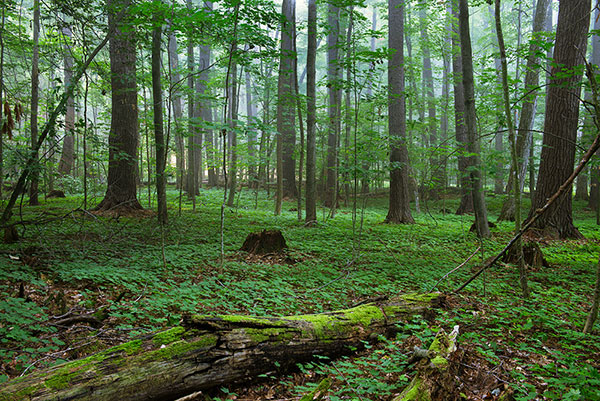
Aaron M. Ellison and Eric Zeigler
Chasing Odysseus Through Deep Time: Contextualizing Climate Change
Is the current planetary state of emergency uniquely salient or simply a snapshot of endlessly repeating and evolving processes of life on Earth? We argue that our perception of living through an ecological crisis arises from our short lifespans and myopic worldviews that amplify our fears of change. To shatter this perception and develop strategies for coping with (ecological) changes measured and informed by a reality extending in time beyond our lived memories, we re-employ deadpan photography, exploring views of our world that seem superficially familiar yet strategically detach us from our sense of control.
We are living in a time with no precedent in the relatively brief 200,000 years of human history. The planet is warming at a rate unseen in over 400 million years[1] while the climate is becoming increasingly chaotic,[2] biodiversity is declining precipitously,[3] and novel zoonotic diseases are appearing with catastrophic consequences for human health and society.[4] Is this planetary “state of emergency” an exception, or is it the rule?
Most people would answer that it is an exception, and a bad one at that. In this pessimistic view, Earth is at the brink of a “tipping point” beyond which it will no longer be able to sustain us or any other species. Contemporary Cassandras call on us to heed the alarm, stanch the bleeding, and return the Earth to a sustainable, healthy state.[5] Others are more optimistic. Although the state of emergency may be an exception, their view is that it is no cause for alarm. Rather, like a modern-day Tiresias, the optimistic exceptionalists assert that we are nowhere close to a tipping point (if one even exists)[6] or that after we pass through and beyond it, as the EcoModernists claim,[7] [8] human ingenuity and technological progress will ensure that the world to come will be a much better place.[9] [10]
What unites Cassandra and Tiresias in the present day is that both consider our current state of emergency to be a unique departure from the normal condition of planetary health and stability. Their difference is one of perspective. Cassandra sees Earth’s health and stability receding from view in her rear-view mirror, whereas Tiresias sees us accelerating toward a healthy and stable future that will become clearly visible just around the next bend.
But what of those who sail the fraught waters between the exceptionalists’ rocks where Scylla and Charybdis dwell? Rather than returning to Circe’s enchanted world, either to avoid Cassandra’s desolate visions or by sticking with business-as-usual while awaiting Tiresias’ bright future, Odysseus and his crew focused on how to move ahead and navigate the roiling waters of the present with no expectation that they would let up any time soon. Similarly, our present emergency requires us to move ahead into a new future despite the costs of such a move to our reigning ideology.[11]
That ideology, the backbone of the “Capitalocene,”[12] ties the accumulation of capital to the “silencing [of] the displaced, killed, and enslaved whose homelands have been assimilated and whose lives have, indeed, been changed forever; erased even.”[13] As modern-day Odysseuses navigating the Capitalocene, we would do well to recall the worldview expressed more than eighty years ago by Walter Benjamin: “The tradition of the oppressed teaches us that the ‘state of emergency’ in which we live is not the exception but the rule. We must attain to a conception of history that is in keeping with this insight.”[14] And, we would add, a similar conception of the present and the future.
For us, the uncertainty and instability inherent in a state of emergency are the norm, and our current planetary emergency is but one in a long series of exceptions that have been instrumental in shaping not only humanity and its civilizations,[15] but all of Earth’s biodiversity. Indeed, it has been suggested that periods of intense climatic and environmental instability have accompanied the most dramatic events in the six-million-year evolution of modern humans from their last common primate ancestor who walked on all fours.[16] Similarly, singular events and times of climatic and environmental instability have coincided with the five previous “mass extinctions” over the four-billion-year history of Earth. Each of these was followed by the origin and evolution of unique species, dramatic increases in biodiversity, and a large-scale reorganization and restructuring of Earth’s ecosystems.[17] Similar dynamics can be seen in the smaller and more frequent, albeit still large, extinction events traceable from the fossil record[18] and may be playing out once again in the “sixth mass extinction” that, it is often asserted, is currently unfolding around us.[19]
If instability and uncertainty are the normal state of affairs, why do we not see this, much less ask how to live with it? Doing so would require us to fully abandon the prelapsarian ideals dating at least to Virgil[20] and still undergirding not only ecology and environmental science[21] but also art and literature, which are both the source and the reflection of cultural ideals and biases (including ecological ones).
With respect to the climate emergency and its associated rapid environmental change, Amitav Ghosh suggests that “the Anthropocene presents a challenge […] to our commonsense understandings and beyond that to contemporary culture in general. […] [The] climate crisis is also a crisis of culture, and thus of the imagination.”[22] According to Ghosh, mainstream art and literature conceal the instability and uncertainty that characterize climate change,[23] and only unimaginative writers would include the heretofore improbable or unbelievably weird weather associated with climate change: “Only writers whose imaginative resources were utterly depleted would fall back on a situation of such extreme improbability.”[24]
Ghosh does suggest that science fiction, “cli-fi” (i.e., climate-change fiction), and other marginalized writings have done a better job describing climate change and its ramifications. However, much science fiction appears to have joined Ghosh’s literary mainstream.[25] Recent annual compilations of “the best” science fiction and fantasy also generally ignore the seemingly improbable events associated with climate change and the climate crisis,[26] even though such events now frequently headline the daily news around the world.
Ghosh regards instability and uncertainty as standing outside of, and being “peculiarly resistant to the customary frames that art and literature have applied to ‘Nature’: […] they are instances, rather, of the uncanny intimacy of our relationship with the nonhuman.”[27] Like Bruno Latour, Ghosh locates this resistance in our embrace of modernity and the “‘partitioning’ or deepening [of] the imaginary gulf between Nature and Culture: the former comes to be relegated exclusively to the sciences and is regarded as being off-limits to the latter.”[28] Ironically, however, we find still photography, a quintessential practice of Modernism whose relationship to “art” has long been debated,[29] to be of particular value in identifying the dynamics, instability, and uncertainty of nature. Further, we find that photographs can work as posthumanist “heterogenous assemblages”[30] that undo the Cartesian dualisms built into our physical and conceptual environments. The following examples illustrate these convictions.
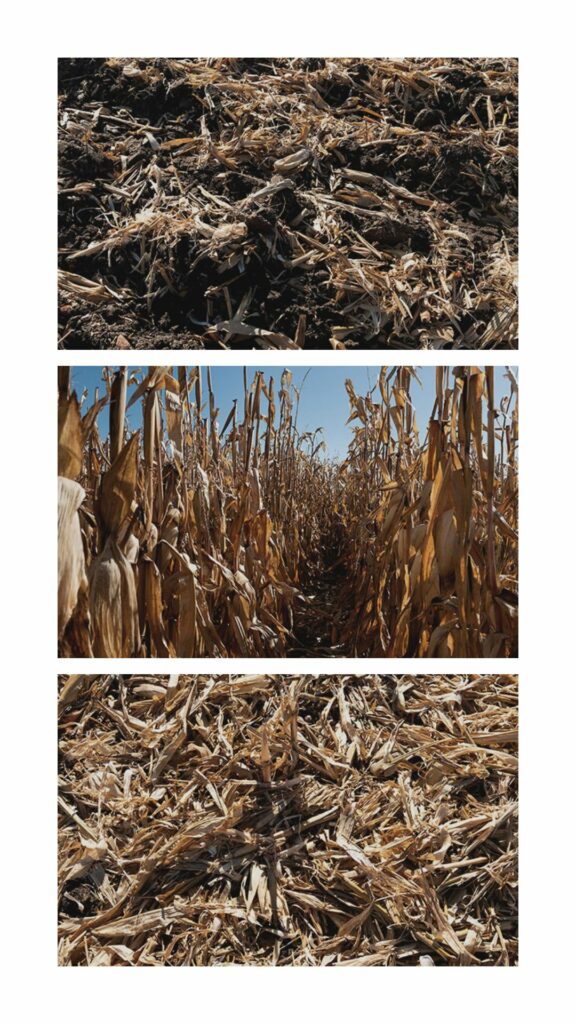
In northwest Ohio (USA), the entire present-day landscape has been engineered by humans, who have changed the region from an impassible swamp teeming with clouds of mosquitos carrying malaria[31] into one that now supports industrial agriculture while bearing few reminders of its dynamic history. In our Great Black Swamp Series, we photographed three different trajectories of environmental instability, none of which illustrate the “true” or “natural” state of the region.
The first three images show the annual cycle of planting, growth, and harvest of corn in the rich loamy soil exposed by the draining of the swamp. An indicator of the magnitude of the environmental changes wrought by draining this swampy region for agriculture—roughly the size of 1½ Luxembourgs—is the change in the speed of travel across it. In the 1820s, it could take more than a week to traverse the single 48-km, muddy road carved through the swamp. Indeed, it was not uncommon for travelers to spend up to three nights at one of the 31 taverns scattered along the length of the road before they could move their animals and wagons far enough down the road to sleep at the next tavern.[32] Two centuries later, the area is now crossed by two major multilane highways and the same distance can be cleanly traversed in less than 30 minutes.

The second-growth forest in the fourth and fifth images sits on the Fallen Timbers Battlefield, the final site where American Indian tribes were dispossessed of these lands.[33] This event, which coincided with the draining of the swampland, allowed the European colonists to begin the aforementioned agricultural transformation of the landscape. But not all the farmlands remain today. As farm fields were abandoned for a variety of reasons, they were colonized by trees. But rather than let nature “take its course,” people are attempting to “restore” it to its “original” state. As part of this restoration effort, oaks, maples, sycamores, and cherry trees have been planted between the self-sprouting cottonwoods in what was, as recently as 2003, a farm field. The restoration will never be complete, however, as at least two key species—white and green ash—have all but disappeared in the maw of an introduced beetle, the emerald ash borer.[34] The outcome of this ecological change will doubtless be as invisible to future inhabitants as the specter of the swamp is to us now.
What is the original state of this forest, the benchmark for its restoration? The few fragmented remnants of unlogged, old-growth forest that survive in this transformed landscape have been preserved by the Great Black Swamp Conservancy.[35] The sixth and seventh images illustrate these “undisturbed” forest patches in the Goll Woods State Nature Preserve.[36]
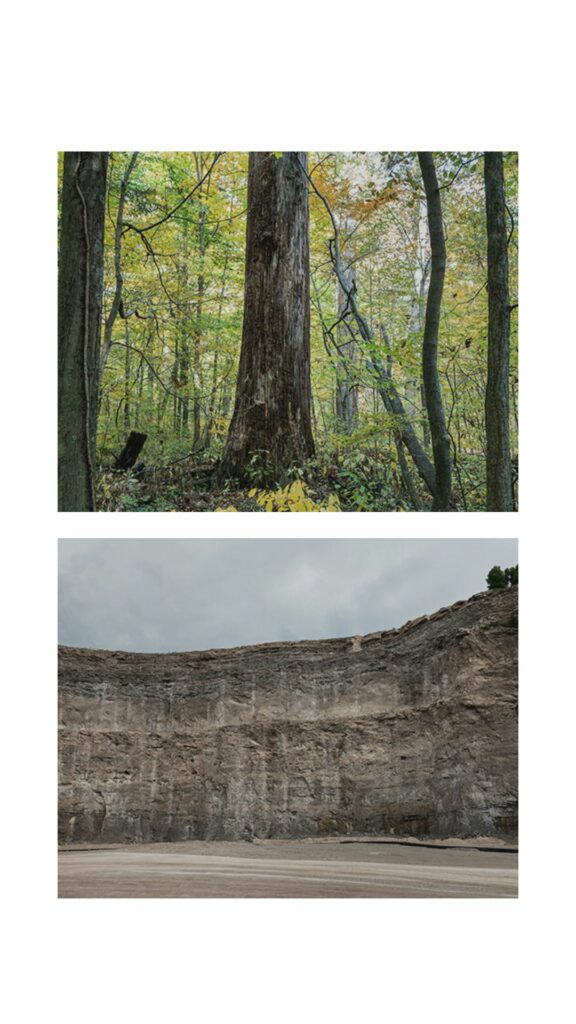
In the old-growth forest of Goll Woods, we can see large chinquapin and burr oaks living and decaying among young saplings waiting to take their place.
And yet, the anthropogenic drama of the last 200 years is as nothing compared to the changes shaped by millions of years of “natural” climate change. The vast beds of Devonian limestone (image 8) laying across the region bear witness to this deeper history. These layers of rock filled with fossilized parts of creatures that have long since disappeared are all that remain of an ancient seabed. These rocks also tell us that life persisted and diversified after the Late Devonian mass extinction event.[37] Even though Earth passed through what we would today consider a disastrous tipping point, nature continued to traverse a range of trajectories that, despite our best efforts, will long outlast our own species, Homo sapiens.
Images 1-8: Great Black Swamp Series #1 (October-December 2022). Top to Bottom: Tilled Soil; Ripe Standing Corn; Stalks of Harvested Corn; Planted Oak Saplings; Second Growth Forest; Old Growth Forest 1; Old Growth Forest 2; Devonian Limestone. All images © Eric Zeigler and Aaron M. Ellison.
The need for food and shelter, which causes humans and many other organisms to modify their environment,[38] is not the world’s only agent of change. Earth also experiences episodes of fire, which consistently lead to regrowth and regeneration, but slow regeneration lacks the combustive drama of flames and is rarely captured by the 24/7 news cycle. Nonetheless, nature’s long-term regeneration and metamorphosis is well suited to a “deadpan photographic approach” that refuses “hasty categorizations of good, bad, best, or worst objects or people in the world.”[39]
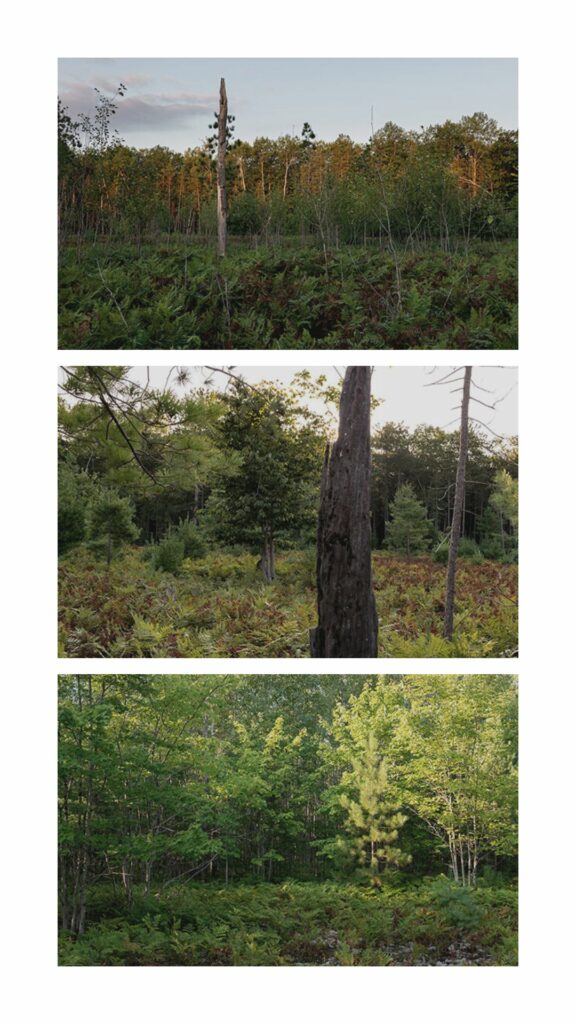
Our sequential series of photographs in AfterFire: Cut and Burn Plot/Regrowth Series, University of Michigan Biological Station pays homage to Bernd and Hilla Becher’s gridded photographic typologies, representative of what photography critic Charlotte Cotton has called the deadpan: a “dispassionate, patient, and keenly sharp type of photography.”[40] The consistent height of the camera, distance to subject, and natural lighting creates the impression that the photographs describe reality without the attitude of an author.[41] The lack of attitude in our images of test plots that have remained essentially untouched after being logged, cut, and burned suggests that human agency is not required for environmental “restoration.” Indeed, these experimental plots are living trajectories of regeneration that, with no “management” or replanting, still have led to a range of biodiverse and ecologically functional forest ecosystems.
These six images span 121 years—longer than an average human lifespan. We cannot directly experience this amount of time, and the recovery of these forests after they are incinerated is an abstraction. Our photographs illustrate that forest (re)growth is continuous and, to us, apparently endless. Expanding our temporal perspective ameliorates the dejection we often feel on seeing the rapid post-fire emergence of weedy “invasive” plants, such as bracken fern, and their subsequent dominance of the forest floor (images 1–3).
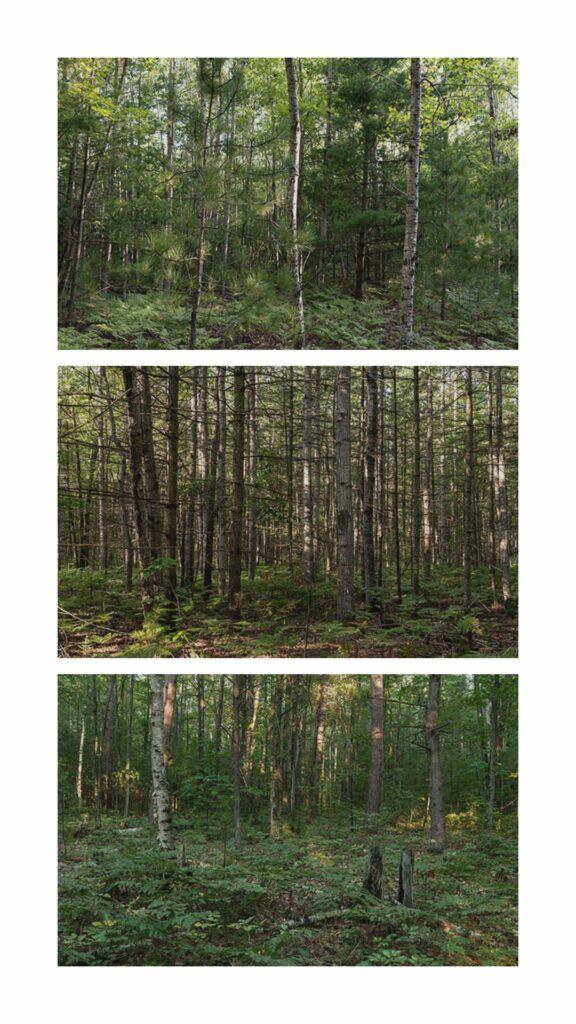
This dominance is only transitory.[42] Through these chronological sequences (“chronosequences”), we see the gradual return of a middle-aged forest. The sun-filled openings are punctured by groups of aspens that quickly sprout, grow, and delineate areas of more and less shade (image 4). Eastern white pines then displace the aspens (image 5). Maples and oaks are the last to establish and mature, but by the sixth photograph in this series, they are well represented in a diverse forest in which little evidence remains of the 1901 conflagration.
After the more than 100 years of regrowth captured in these images, the bracken is long gone, some early successional species have fallen, and the patches of light reaching the park-like forest floor provide energy to the next generation of trees. This “mixed-age” stand—diverse in species and their ages—will, after the passage of yet more time, be enriched by fallen, aged giants that nourish the soil as their trunks decompose. And after other “disturbances”—windstorms, lightning strikes, and ongoing climate change—the forest will again regenerate, following new trajectories from different beginnings.
Images 9-14: AfterFire: Cut and Burn Plot/Regrowth Series, University of Michigan Biological Station (August/September 2022). Top to Bottom: 2017 #1; 2017 #2; 1998; 1980; 1936; 1901. All images © Eric Zeigler and Aaron M. Ellison.
In contrast, Disturbance Series, University of Michigan Biological Station provides glimpses of different outcomes of ecological disturbance in a single landscape: forests growing on the sandy soils of the northern tip of Michigan’s lower peninsula.
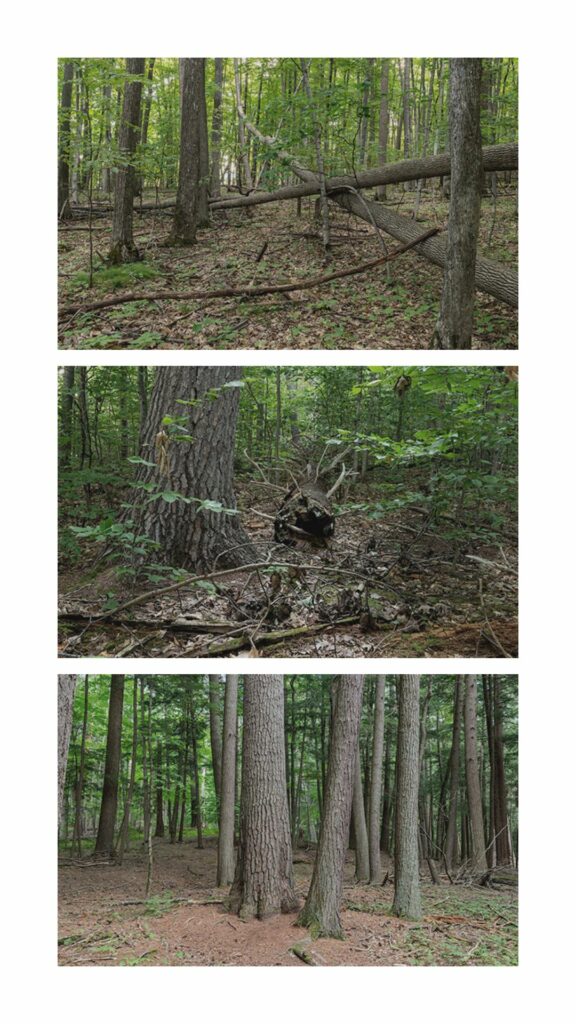
In the first image, we see ash trees, recently killed by the emerald ash borer, fallen and crisscrossing an otherwise minimally disturbed site. These trees are located 500 km to the north of those of the Great Black Swamp and were killed more recently; their bark is still intact and tight. This disturbance has radiated outward in time, distorting our sense of place in a world where it takes but an afternoon to travel between these two forests.
Time also affects different trees differently. The fallen white pine (second image) has been laying on the forest floor for much longer than the ash trees that fell only meters away, but the pine log is as intact as the ash. Indeed, the decay rates of hardwoods (like ash) and softwoods (like pine) differ dramatically because of the different fungi that decompose them.[43]
Even “old-growth” has uncertain meaning. Compare the third image in this Disturbance Series to the sixth and seventh images in the Great Black Swamp Series. In all three, we see trees of different sizes (and ages), but the understories—at our eye level—are not at all the same. These differences confound us and make it nearly impossible to identify generalities about ecological “disturbances,” much less how these disturbances might affect us during our relatively short lifespans.
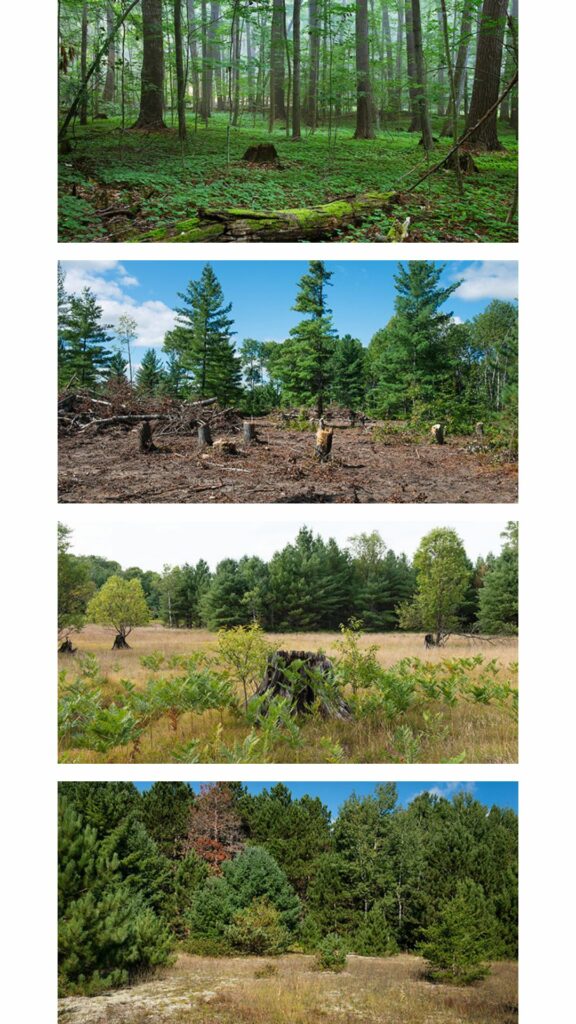
Compare thinning land for lumber (image 4) to building housing on clear-cut land (image 5) for still more human beings in an environment with ready access to water, clean air, and in a climatic zone that will not bear the brunt of global warming. Are these sustainable economic necessities, transient disturbances, or “ecocide”? We know from experience that thinned forests regrow quickly whereas the evidence of clear cuts remains visible for far longer (images 6, 7). Does “longer” pertain over multiple lifespans or in geological time?
Finally, what is the difference between a “natural” disturbance and an anthropogenic one? Each of the images in the Disturbance Series asks us how we might choose to manage “our” forests. Is it best to let “invasives species” like the emerald ash borer run their course and let the forest feast on the rush of deadwood while it lasts? What is our temporal baseline for restoration? Before European settlement or to the last glacial period, when this landscape was cleared and flattened by retreating rivers of ice? Should we preserve tiny fragments of old-growth forest—theme parks that let us experience a vegetal vision of the past but are too small for thriving wildlife? We must ask: what is a “disturbance,” really?
Our aesthetic responses to these images are not the best way to assess this dynamic landscape. Context and values are also essential. The requisite second step of viewing a deadpan photographic image is to consider the values we bring to the images and to recognize that they are insufficient to take in the entirety of what regrowth can do.
Images 15-21: Disturbance Series, University of Michigan Biological Station (August/ September 2022). Glacial Lake Shore #1; Glacial Lake Shore #2; Old Growth White Pine; Partially Cut Old Growth; Fresh Cut Site; Century-Old White Pine Stump Field; Historic Farmland. All images © Eric Zeigler and Aaron M. Ellison.
Our perception that climate change is a climate emergency is reinforced by our lived perspective: whatever is happening is happening to us, for us, at this place—and now. This immediate—and static—view is also what a photograph shows us at first glance and could bear some responsibility for the modes of concealment identified in art and literature by Ghosh. More broadly, we think that this immediate view is a prerequisite for Cassandra’s predictions of doom, which in turn are echoed in Montaigne’s famous assertion: [a]insi fera la morte de toutes choses notre mort.[44] In our own time, Montaigne has been reinterpreted by Morselli, among other contemporary Cassandras:
One of the pranks played by anthropocentrism is to suggest that the end of our species will bring about the death of animal and vegetable nature, the end of Earth itself. The fall of heavens. There is no eschatology that doesn’t assume man’s permanence is necessary to the permanence of anything else. It’s accepted that things might have been before us; unthinkable that they could ever end after us.[45]
In contrast, our three examples show unevenly spaced, linear, and non-linear temporal transitions that provide distance and perspectives for (re)imagining the world as it continuously unfolds and evolves around us. The linear sequence (AfterFire) is the most Tiresian. While acknowledging the traditions steeped in technique and technology that have conditioned how we view deadpan photographs, AfterFire upends the idea that destruction is somehow permanent. Deadpan imagery also superficially enhances our sense of time by bringing factual information to the surface and gives us a feeling that we understand how reality will unfold in the future. AfterFire and similar chronosequences commonly studied by ecologists balance the familiar with the unfamiliar in approachable ways and suggest that through management or natural restoration, the world—with or without us—will once again return to its prelapsarian state of balance.[46]
Sequences of deadpan images also can impede our sense of time. The reliance of any deadpan image on context for its legibility is complicated by the varying associations the viewer must make between images to reconcile their coexistence. The multiplicity of times, places, and perspectives of a variety of organisms (Umwelten)[47] crash against one another, illuminating the near-simultaneous historical progressions and regressions of Benjamin’s dialectic.[48] This multiplicity of perspectives is most clearly seen in the contrast between the three non-linear chronosequences in the Great Black Swamp Series, each of which adopts the deadpan conventions of comparable eye level, light, and distance to subject, and the final image in that series, which captures more than 450 million years of deep time in a single, vast section of limestone where time runs in reverse from top to bottom. Neither Cassandra nor Tiresias can effectively grapple with the perpetual ecological imbalance implied by the worldviews captured in these images. Their “inner logic has no sense of the contingent values, practices, or forms of meaningful involvement that constitute the human world”[49] and, we think, can only be grasped by Odysseus and his ilk as they navigate the world’s constantly changing, often chaotic, ecologies. The emergency is the norm: work with change, embrace it, and live it.
AARON ELLISON is a photographer, sculptor, writer, and Senior Research Fellow Emeritus in Ecology at Harvard University. His research and artistic practice focus on the disintegration and reassembly of ecosystems following natural and anthropogenic disturbances. ERIC ZEIGLER is Assistant Professor of Art at the University of Toledo. His research and artistic practice interrogate the history of the photographic process by exploiting problematic contemporary western cultural categorizations and presumptions that are placed on photographic and lens-based imagery. WORKING TOGETHER, Eric and Aaron explore unknown worlds beyond our current understanding. Their joint work currently centers on non-anthropocentric (posthumanist) aesthetics and creative photodocumentation of forests and deep time.
amellison17@gmail.com; eric.zeigler@utoledo.edu
dePICTions volume 3 (2023): Critical Ecologies
[1] Gavin L. Foster, Dana L. Royer, and Daniel J. Lunt, “Future Climate Forcing Potentially Without Precedent in the Last 420 million Years,” Nature Communications 8.4 (April 2017), DOI: 10.1038/ncomms14845.
[2] Ibiyinka Fuwape, Sunday Oluyamo, Babatunde Rabiu, and Samuel Ogunjo, “Chaotic Signature of Climate Extremes,” Theoretical and Applied Climatology 139.1-2 (2020): 565–576.
[3] Sandra Díaz, Josef Settele, Eduardo S. Brondízio, Hien T. Ngo, et al., “Pervasive Human-Driven Decline of Life on Earth Points to the Need for Transformative Change,” Science 366.6471 (2019), DOI: 10.1126/science.aax3100.
[4] Cristiano Salata, Arianna Calistri, Cristina Parolin, and Giorgio Palù, “Coronaviruses: A Paradigm of New Emerging Zoonotic Diseases,” Pathogens and Disease 77.9 (2019), DOI: 10.1093/femspd/ftaa006.
[5] See, for example, Anthony D. Barnosky and Elizabeth A. Hadly, Tipping Point for Planet Earth: How Close Are We to the Edge? New York: Thomas Dunne Books, 2016; Timothy M. Lenton, Johan Rockström, Owen Gaffney, Stefan Rahmstorf, et al., “Climate Tipping Points—Too Risky to Bet Against,” Nature 575. 7784 (2020): 592–595; and Luke Kemp, Chi Xu, Joanna Depledge, Kristie L. Ebi, et al., “Climate Endgame: Exploring Catastrophic Climate Change Scenarios,” Proceedings of the National Academy of Sciences 119.34 (2022), DOI: 10.1073/pnas.2108146119.
[6] Barry W. Brook, Erle B. Ellis, and Jessie C. Buettell, “What Is the Evidence for Planetary Tipping Points?” in Effective Conservation Science: Data Not Dogma, edited by Peter Kareiva, Michelle Marvier, and Brian Silliman, Oxford: Oxford University Press, 2017, 51–57.
[7] John Asafu-Adjaye, Linus Blomqvist, Stewart Brand, Barry Brook, et al., “An Ecomodernist Manifesto,” April 2015 [21 November 2022].
[8] We note, however, that the visions and ideals of the EcoModernist manifesto have uncomfortable, albeit perhaps unintentional, racist precursors. For example, see Alexander F. Skutch, “Back—or Forward—to Nature?” Nature Magazine 39.9 (1946): 457-460, 498.
[9] For example, see Steven Pinker, Enlightenment Now: The Case for Reason, Science, Humanism, and Progress, New York: Penguin, 2015.
[10] In Greek mythology, Tiresias (also Teiresias) is a transgendered and blind prophet of Apollo. We use them here as the epitome of the optimistic exceptionalists because of their prophecy to Odysseus that he would eventually return to Ithaca, albeit after many trials. An example of his optimism can be found in Lucien’s parody of Book XI of the Odyssey, in which Tiresias answers Menippus’s question of what is the best life:
“The life of the ordinary man is the best and most prudent choice; cease from the folly of metaphysical speculation and inquiry into origins and ends, utterly reject their clever logic, count all these things idle talk, and pursue one end alone—how you may do what your hand finds to do, and go your way with ever a smile and never a passion.”
See Lucien of Samosata, The Works of Lucien of Samosata, translated by W. H. Fowler and F. G. Fowler, in four volumes, Oxford: Clarendon, 1905 (quote from vol. I, p. 167); and R. Bracht Branham, “The Wisdom of Lucian’s Tiresias,” The Journal of Hellenic Studies 109 (1989): 159–160.
Cassandra is also a figure from Greek mythology. Like Tiresias, she was a prophet of Apollo, but unlike the former, she rarely foretold positive events. Among other prophecies, Cassandra foretold the Greeks hiding within the Trojan Horse and Odysseus’ decade of wandering, during which he visited Tiresias in the underworld. We use Cassandra here as the epitome of the pessimistic exceptionalists because she always spoke true prophecies but, because she had been cursed by Apollo for spurning his advances, her prophecies were never believed.
[11] Naomi Klein, This Changes Everything: Capitalism vs The Climate, New York: Simon & Shuster, 2014, 18.
[12] Jason Moore, who has popularized the term Capitalocene, dates the neologism to 2009 and attributes it to the Marxist historian Andreas Malm, then a PhD student at Lund University in Sweden. See Jason W. Moore, ed., Anthropocene or Capitalocene? Nature, History, and the Crisis of Capitalism, Oakland: PM Press, 2016, xi.
[13] Eileen Crist, “On the Poverty of Our Nomenclature,” in Moore, Anthropocene or Capitalocene? 14-33, here 18. We note that placing the Capitalocene in opposition to the Anthropocene is perceived by some as a strong critique of the scientific approaches used to study climate change and “undermine[s] our ability to carry through the radical social and geophysical transformations that are needed in our time.” See Ian Angus, “Knocking Down Straw Figures,” International Socialist Review 103 (Winter 2016–17) [25 February 2023]; John Bellamy Foster and Brett Clark, “The Capitalinian: The First Geological Age of the Anthropocene,” Monthly Review 73.4 (September 2021): 1–16; and Hans Baer, “Anthropocene or Capitalocene? Two Political Ecological Perspectives,” Human Ecology 45.4 (2017): 433–435.
[14] Walter Benjamin, Illuminations, translated by Harry Zohn, edited and with an introduction by Hannah Arendt, New York: Schocken, 1968, 257.
[15] Nearly a century ago, Alfred North Whitehead wrote: “It must be admitted that there is a degree of instability which is inconsistent with civilization. But, on the whole, the great ages have been unstable ages” (Alfred North Whitehead, Science and the Modern World: Lowell Lectures 1925, New York: Macmillan, 1925, 299).
[16] See Rick Potts and Chris Sloan, What Does It Mean to Be Human? Washington DC: National Geographic, 2010, and the accompanying interactive exhibition at the Smithsonian National Museum of Natural History, The Smithsonian’s Human Origins Program, 2018 [11 March 2022].
[17] See, for example, Peter R. Grant, Rosemary R. Grant, Raymond B. Huey, Marc T. J. Johnson, et al., “Evolution Caused By Extreme Events,” Philosophical Transactions of the Royal Society of London, Series B, Biological Sciences, 372.1723 (2017), DOI: 10.1098/rstb.2016.0146.
[18] See, for example, John Alroy, “Dynamics of Origination and Extinction in the Marine Fossil Record,” Proceedings of the National Academy of Sciences 105.Supplement 1 (2008): 11536-11542.
[19] Compare Anthony D. Barnosky, Nicholas Matzke, Susumu Tomiya, Guinevere O. U. Wogan, et al., “Has the Earth’s Sixth Mass Extinction Already Arrived?” Nature 471.7336 (2011): 51-57, with Chris D. Thomas, Inheritors of the Earth: How Nature is Thriving in the Age of Extinction, New York: PublicAffairs, 2017.
[20] Richard Jenkyns, “Virgil and Arcadia,” The Journal of Roman Studies 79.1 (1989): 26-39.
[21] Aaron M. Ellison, “The Suffocating Embrace of Landscape and the Picturesque Conditioning of Ecology,” Landscape Journal 32.1 (2013): 79-94.
[22] Amitav Ghosh, The Great Derangement: Climate Change and the Unthinkable, Chicago: University of Chicago Press, 2016, 9.
[23] “Most forms of art and literature were drawn into the modes of concealment that prevented people from recognizing the realities of their plight” (Ghosh, The Great Derangement, 11).
[24] Ghosh, The Great Derangement, 16.
[25] The mainstreaming of science fiction and its “SF” cognates was clearly (albeit perhaps unintentionally) articulated by Donna Haraway in her description of a “relentlessly contingent SF worlding of living and dying, of becoming-with and unbecoming-with, of sympoiesis, and so, just possibly, of multispecies flourishing on earth” (Donna J. Haraway, Staying with the Trouble: Making Kin in the Chthulucene, Durham: Duke University Press, 2016, 40). For Haraway, “SF” includes not only science fiction, but also “string figures…entwin[ing] me in the poiesis—the making—of speculative fabulation, science fiction, science fact, speculative feminism, soin de ficelle, so far” (Haraway, Staying with the Trouble, 31).
[26] Notable recent examples include the works anthologized in John Joseph Adams and Veronica Roth, eds., The Best American Science Fiction and Fantasy 2021, Boston: Mariner Books/HarperCollins, 2021.
[27] Ghosh, The Great Derangement, 32-33.
[28] Ghosh, The Great Derangement, 68. Here, Ghosh is paraphrasing Latour’s discussion of progress and modernity (see Bruno Latour, We Have Never Been Modern, translated by Catherine Porter, Cambridge: Harvard University Press, 1993).
[29] See, for example, Walter Benjamin, A Short History of Photography, translated by Stanley Mitchell, Oxford: Oxford University Press, 1972; Theodor W. Adorno, Aesthetic Theory, edited by Gretel Adorno and Rolf Tiedemann, translated and edited by Robert Hullot-Kentor, Minneapolis: University of Minnesota Press, 1997; Susan Sontag, On Photography, New York: Penguin, 1977; Roland Barthes, Camera Lucida: Reflections on Photography, translated by Richard Howard, New York: Hill & Wang, 1981; and Hagi Kenaan, Photography and its Shadow, Stanford: Stanford University Press, 2020.
[30] Giovanni Aloi and Susan McHugh, “Envisioning Posthumanism,” in Posthumanism in Art and Science: A Reader, edited by Giovanni Aloi and Susan McHugh, New York: Columbia University Press, 2021, 1-24, here 2.
[31] Jim Mollenkopf, The Great Black Swamp: Historical Tales of 19th-century Northwest Ohio, Toledo: Lake of the Cat Publishing, 1999, 19.
[32] Mollenkopf, The Great Black Swamp, 41.
[33] National Park Service, “Fallen Timbers Battlefield and Fort Miamis Historic Site,” 26 February 2021 [1 December 2022].
[34] Daniel A Herms and Deborah G. McCullough, “Emerald Ash Borer Invasion of North America: History, Biology, Ecology, Impacts, and Management,” Annual Review of Entomology 59.1 (2014): 13-30.
[35] Black Swamp Conservancy, “Land We Protect” [1 December 2022].
[36] Ohio Department of Natural Resources, “Goll Woods State Nature Preserve” [1 December 2022].
[37] George R. McGhee, The Late Devonian Mass Extinction: The Frasnian/Famennian Crisis, New York: Columbia University Press, 1996.
[38] F. John Odling-Smee, Kevin N. Laland, and Marcus W. Feldman, Niche Construction: The Neglected Process in Evolution, Princeton: Princeton University Press, 2013.
[39] Aron Vinegar, “Ed Ruscha, Heidegger, and Deadpan Photography,” Art History 32.5 (2009): 852-873, here 869.
[40] Charlotte Cotton, The Photograph as Contemporary Art, Fourth Edition, New York: Thames & Hudson, 2020, 82.
[41] Peter Lančarič, “The Theoretical and Philosophical Basis of the Deadpan Aesthetics,” European Journal of Science and Technology 13.6 (2017): 107-118, here 108.
[42] Aaron M. Ellison, “Decomposition and Memory,” in Forest Under Story: Creative Inquiry in an Old-growth Forest, edited by Nathanial Brodie, Charles Goodrich, and Frederick J. Swanson, Seattle: University of Washington Press, 2016, 77-83.
[43] Tiemo Kahl et al., “Wood Decay Rates of 13 Temperate Tree Species in Relation to Wood Properties, Enzyme Activities, and Organismic Diversities,” Forest Ecology and Management 391.1 (2017): 86-95, here 91.
[44] “Our death will bring about the death of all things.” In Michel Seigneur de Montaigne, Essais, Edition Nouvelle, Paris: Chez Michael Sonnius, 1595, 43.
[45] Guido Morselli, Dissipatio H.G., translated as The Vanishing by Frederika Randall, New York: NYBooks, 1977, 53. We note that, unlike contemporary Cassandras, Morselli’s reinterpretation of Montaigne was intentionally ironic.
[46] Alan Weisman, The World Without Us, New York: Thomas Dunne/St. Martin’s Press, 2007.
[47] Kalevi Kull, “Umwelt,” in The Routledge Companion to Semiotics, edited by Paul Cobley, London: Routledge, 348-349.
[48] Benjamin, Illuminations, 258.
[49] Kenaan, Photography and its Shadow, 154.


Responses